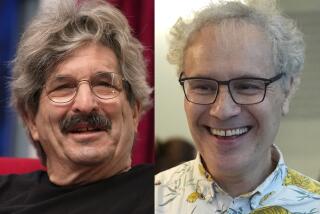Barbara McClintock, 90; Nobel-Winning Geneticist
- Share via
Barbara McClintock, whose keen observations of Indian corn led to a breakthrough in genetics that was overlooked for decades, has died in Huntington, N.Y., at age 90, nine years after becoming the first U.S. woman to win a solo Nobel Prize in science.
Her death Wednesday at Huntington Hospital was of natural causes. She had continued working as a staff scientist at Cold Spring Harbor Laboratory, where she also maintained an apartment, until a few months ago.
McClintock’s discovery of “jumping genes” has had implications for research into aging, cancer and evolution. While conventional wisdom held that genes were strung along a chromosome like beads on a string, McClintock realized while researching the pigmentation of maize kernels that small segments of genetic material could move, affecting future generations of cells. In an intuitive leap, she discerned that heredity was more subtle and complicated than had previously been believed.
That work brought her the 1983 Nobel Prize in Physiology or Medicine, ranking her with just two other women who had won an unshared Nobel in the sciences: Marie Curie in 1911 and Dorothy C. Hodgkin in 1964.
McClintock also was the first lifetime fellow of the John D. and Catherine T. MacArthur Foundation, which awarded her a $60,000 annual stipend in 1981. She was awarded the Albert Lasker Basic Medical Research Award that year as well.
James Watson, Cold Spring Harbor director and co-discoverer of the structure of DNA, has called McClintock one of the three most important figures in genetics, along with Gregor Mendel and Thomas Hunt Morgan.
But in 1951, when she reported her insight at a symposium, she was greeted with silence. In 1953, when she published a journal article on jumping genes, she received only three requests for reprints.
Perhaps the reason for the resounding lack of reaction, one Nobel committee member speculated years later, was that “only about five geneticists in the world could appreciate” the findings at the time “because of the complexity of the work.” DNA had just recently been shown to be the basic molecule of heredity. Molecular biology was not yet a major field of study.
“It was just too arcane for people to understand,” said Cold Spring Harbor laboratory spokesman Nathaniel Comfort. “It came totally out of left field.”
McClintock enrolled at Cornell University in 1919, hoping to study the breeding of plants, but the department would not accept her as a major because she was a woman. So her undergraduate degree was in the related field of botany. As a graduate student at Cornell, she turned to plant genetics, earning her doctorate in 1927. Her reminiscences of those days included tales of playing her banjo at the local cafes.
After teaching and research positions at Cornell, the National Research Foundation, the Guggenheim Foundation and the University of Missouri, McClintock arrived in 1941 at the Carnegie Institution of Washington’s department of genetics, located at Cold Spring Harbor. She lived and worked there, staying on as the department became an independent laboratory, for more than 50 years.
In 1944, her work on anomalies in corn was recognized by her election to the National Academy of Sciences. She was the third woman to be so honored.
She grew a few acres of maize on a plot at the lab and began to look closely at the colors of the kernels. If a kernel was pale yellow with red spots in it, Comfort recalled Thursday, the spots were found to be collections of cells that had been affected by something while they were forming.
McClintock wondered if the colors had been affected by bits of DNA jumping in to the pigmentation gene and deactivating it, to form the pale parts--then jumping out, reactivating the gene, to form the spots.
McClintock confirmed her hypothesis by carefully controlled crosses of the corn plants, with close attention to the resulting color patterns of the kernels. She also worked with Queen Anne’s lace to show that “jumping genes” could be found at work in other plants.
In the 1970s, when new techniques made it possible for scientists to identify errant gene fragments, McClintock’s results were finally widely accepted and applied to humans, animals and plants.
When she learned about the Nobel Prize from a radio broadcast, she took a walk in the woods to gather walnuts.
Characteristically, she shared the credit with her subject. “It might seem unfair,” she said in a statement, “ . . . to reward a person for having so much pleasure over the years, asking the maize plant to solve specific problems and then watching its responses.”






